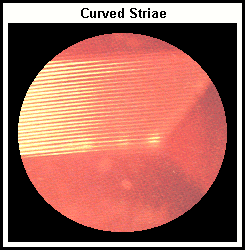Professional Gemologist Certification Course
Identifying Inclusions Found in Synthetic Gems
Curved Striae
Flame fusion grown corundum are the most common synthetics. They come in a variety of colors, are very durable, and exceptionally inexpensive to manufacture.
If, when examining a gem your RI indicates corundum, your next step is to distinguish if it is natural or synthetic. Your first clue that the gem you are examining is a synthetic is poor workmanship. Cheap synthetic rubies and sapphires do not get the care a precious gem does. A clean interior, with no crystal or silk inclusions, is your next clue.
With diffused lighting, look for curved or straight growth lines. Curved lines are difficult to distinguish, because the curvature is very subtle. The first picture shows curved striae on the pavilion main facets of an emerald cut gem. However, you may not see this much. The second picture shows a partial view of the curved striae. It takes practice to make this distinction. Once recognized, you are certain that the gem is a flame fusion synthetic.
Synthetic spinel and alexandrite also exhibit curved striae. The above considerations apply to these stones as well.
Bubbles
Bubbles are common to natural and man made…
Donald Clark, CSM IMG
Never Stop Learning
When you join the IGS community, you get trusted diamond & gemstone information when you need it.
Get Gemology Insights
Get started with the International Gem Society’s free guide to gemstone identification. Join our weekly newsletter & get a free copy of the Gem ID Checklist!
